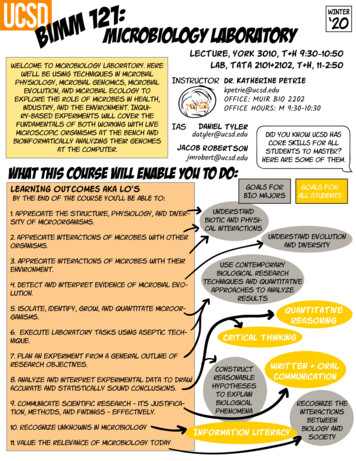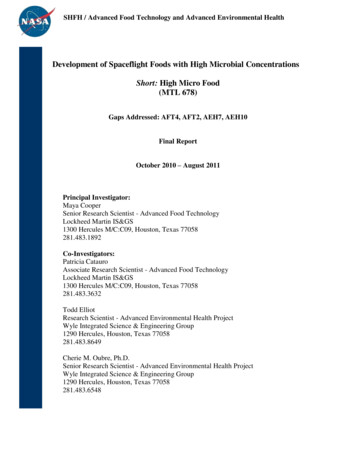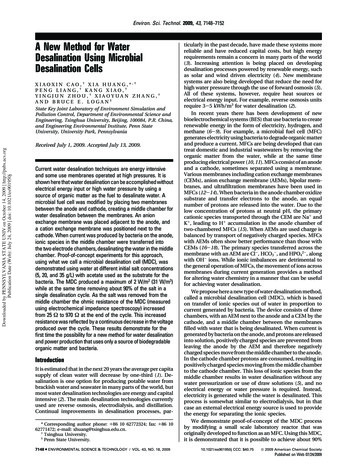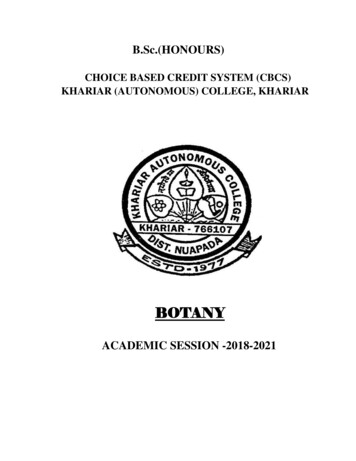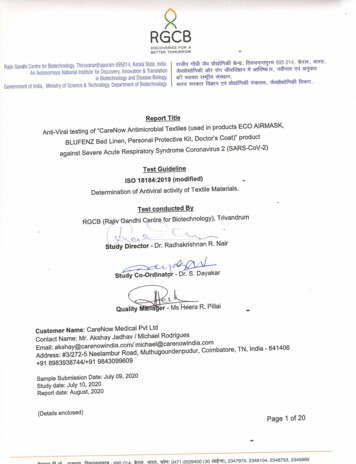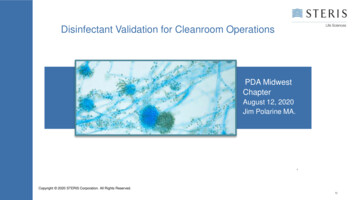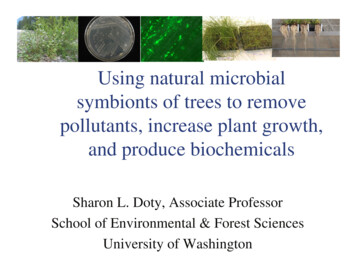
Transcription
Using natural microbialsymbionts of trees to removepollutants, increase plant growth,and produce biochemicalsSharon L. Doty, Associate ProfessorSchool of Environmental & Forest SciencesUniversity of Washington
Plant-Microbe Symbiosis “Symbiosis” means “livingtogether”Commonly known arerhizobia that help legumes(peas, beans, clover) getnutritionAnother common symbiosis iswith mycorrhizae thatassociate with roots of mostplantsRoot nodule on alfalfa
Microbial EndophytesBut relatively new research has pointed to the importance of“endophytes”, microbes that live fully within plants without causingdisease, that provide multiple benefits including nutrition and stresstoleranceBenefits from endophytesPathogen resistanceAnti bacterial compoundsGrowth PromotionHormonesNutrientsStress toleranceDroughtTemperatureRemediation ofpollutants
Research Area 1: PhytoremediationUsing plants for detoxification of pollutants
The Pollution Problem Many types of pollutants Occurs from spills ordeliberate dumping Billions spent worldwide Enormous health costsincluding cancers Large land areas areaffected, making traditionalengineering solutions (suchas excavation) impracticaland too expensive
Phytoremediation Solar‐PoweredPollution‐Removal SystemPoplar and willow are excellent for removal of pollutants due to theirrapid growth, ease of propagation, deep roots, and natural ability toremove and detoxify certain pollutants.April 2000Sept.2002EcoloTree, Inc., Dr. Lou Licht7-year old poplar at a TCE site(Environmental ForestryConsultants, Dr. Jud Isebrands)
International Poplar Commission A branch of the United Nations, the IPC supportsthe use of poplar and willow for improvinglivelihoods around the worldhttp://www.fao.org/forestry/ipc/The IPC working group on EnvironmentalApplications provides guidance on the use ofthese plants for erosion control, stoppingdesertification, phytoremediation, bioenergy, Csequestration, riparian buffers, and moreCurrent Officers: Sharon Doty (Chair),Jaconette Mirck and Andrej Pilipovic (ViceChairs), and Ionnis Dimitriou (TechnicalSecretary)
Research Area 1: PhytoremediationInsecticides (Chlorpyrifos)Solvents (TCE)Polycyclic Aromatic Hydrocarbons (Phenanthrene)Explosives (TNT, RDX)Inorganic Pollutants (Arsenic)
Chlorpyrifos (CPS) is a broadspectrum insecticideAdverse impacts on environmental and human healthCPSA low-birth-weight baby9
Research in our laboratory has demonstrated thatpoplar and willow can take up this insecticide fromwater and degrade it.If these plants were added as a riparian buffer between agriculturalfields and rivers, it may reduce the impact of this pollutant onecosystems and human health.Lee, K. Y., Strand, S. E., and Doty, S. L. 2012. Phytoremediation of chlorpyrifos by Populus and Salix. International Journal ofPhytoremediation 14(1):48-61.This work was sponsored by University of Washington Superfund Research Program, Grant #: NIEHS P42ES004696.
Trichloroethylene (TCE) is a common solvent anddegreaser with a variety of industrial applications. Itis one of the most common pollutants, found in 60%of SuperFund sites across the country60% TCETCE is toxic and cancause cancer
Research in our lab has demonstrated that different varietiesof poplar and willow have different capacities to remove anddetoxify TCE. Some removed more than 40% of the TCEfrom solution within one weekMiller, R. S., Khan, Z., and Doty, S. L. Comparison of trichloroethylene toxicity, removal, and degradation by varieties of Populus andSalix for improved phytoremediation applications. Journal of Bioremediation and Biodegradation S7:001. Doi:10.4172/2155-6199.S7001.This research was funded by NSF Environmental Engineering grant # 0829027
Endophyte-Assisted es the ability of plants to take up pollutants from a wide areawith the ability of the endophytes to rapidly detoxify the chemicals
Screened for endophytes of poplar that degrade trichloroethylene(TCE), and found one strain that rapidly took up anddegraded this important pollutantKang, et al. 2012 Appl.& Environ. Micro. 78(9)3504-3507This research was funded by NSF Environmental Engineering grant # 082902714
Using a similar method, we discovered anotherpoplar tree endophyte that reduces PAH toxicityDay 1Day 19Inoculated with PD1Day 1Day 19Uninoculated controlKhan, Z., et al. (manuscript in preparation)Doty, S. L. 2008. Tansley Review: Enhancing phytoremediation through the use of transgenics and endophytes. New Phytologist 179:318333.
Research Area 2: Increasing PlantGrowth Sustainably using SymbiosisUsing microbes instead of chemical fertilizers
Chemical Fertilizers Synthesized nitrogenfertilizer requireshigh levels of fossilfuel.Cost rises with fossilfuel pricesEnvironmental costsinclude greenhousegas emissions(nitrous oxide) andfouling rivers andother waterwaysWorld Fertilizer Use
Biological Nitrogen Fixation“Fixing nitrogen” means changing the dinitrogen gas in our airto a usable form like ammoniaWell-known examples are rhizobia with legumes and Frankiawith alder trees and certain other woody plants. Both live invisible root nodules.
But some plants grow withoutfertilizer and without rootnodules. Recent researchpointed to endophytes that canfix nitrogen without needingroot nodules.Some examples includesugarcane in Brazil,sweetpotato in East Africa,kallar grass, and rice
Poplar & willow grownaturally in low-nutrientareas. We isolated avariety of endophytesthat can fix nitrogen andpromote plant growthDoty, S. L., et al. (2005) Symbiosis 39: 27-35Doty, S. L., et al. (2009) Symbiosis 47: 23-33Xin, G., et al. (2009) Biology and Fertility of Soils 45:669-674
Endophytes can be isolated from poplar, labeled withfluorescent markers, grown in culture, and reinoculated into plants so we can see colonizationFluorescent image taken after 6 days ofinoculation- Xylem of stem tissue(longitudinal section)Fluorescent image takenafter 6 days ofinoculation – Crosssection of a nodeThree week old internallysterile Nisqually-1 plantinoculated with gfp-WP9Fluorescent image taken after2hrs of inoculation
The endophytes naturally produce plant hormonesthat increase rootingWithout the added microbesWith the added symbionts
Endophytes improved grass health and growthin low nutrient conditionsKentucky bluegrass /- PTD1Wisconsin grass line /- WP19Khan, Z, Guelich, G., Phan, H., Redman, R., and Doty, S. L. 2012. ISRN Agronomy
Increased growth and yields of bell pepper plants grownin low-nutrient soil by adding poplar tree endophytesKhan, Z, Guelich, G., Phan, H., Redman, R., and Doty, S. L. 2012. ISRN Agronomy
Increased growth of tomato and Douglas-fir in nutrient-poor soilCONTROLWith added endophytesDouglas-fir photos:Controls on the left,inoculated withendophytes on theright
Endophytes can improve drought tolerance60% moreroot biomassand 48% moreshoot biomassPerennial rye grass after two weeks of water stress. Plants on the left werecolonized by an endophyte consortia.Khan, Z, Guelich, G., Phan, H., Redman, R., and Doty, S. L. 2012. ISRN Agronomy
Summary of Research Area 2Endophytes of poplar andwillow can help plants byfixing nitrogen, solubilizingphosphate, producing planthormones, and increasingdrought tolerance. Theyassociate not only withpoplar and willow but withmany other types of plantsas well.
Implications for this research:Endophytes For Sustainable Bioenergy Crop GrowthThe DOE’s choice plant for biofuel for thePacific NW is hybrid poplar. An AFRI grant isfocused on developing these biofuels in anenvironmentally and economically sustainablemanner. http://hardwoodbiofuels.org/28
Implications for this research:Endophytes For Sustainable AgricultureChemical fertilizers can damageecosystems and release potentgreenhouse gases. This research maylead to a reduction in the need forchemical fertilizers by re-establishingnatural plant-microbe symbiosesGulf of Mexico “dead zone”www.noaa.gov29
Research Area 3: BiochemicalProductionUsing endophytes to produce biofuels
Rhodotorula mucilaginosa strain PTD3 Naturally occurring, endophytic, robust,pigmented yeast from poplar trees Rapidly and effectively utilizes both 5Cand 6C sugars, producing bioethanol andbioxylitol Tolerant of phytochemicalsBura, R., Vajzovic, A., and Doty, S. L. 2012. Novel endophytic yeast Rhodotorulamucilaginosa strain PTD3. I. Production of xylitol and ethanol. Journal of IndustrialMicrobiology & Biotechnology (in press) DOI: 10.1007/s10295-012-1109-xVajzovic, A., Bura, R., and Doty, S. L. 2012. Novel endophytic yeast Rhodotorulamucilaginosa strain PTD3. II. Production of xylitol and ethanol in the presence of inhibitors.Journal of Industrial Microbiology & Biotechnology 39(10):1453-1463.
Overall Implications for thisresearch: Climate change mitigation Planting more trees formultiple purposes(phytoremediation,bioenergy, and otherenvironmental applications)can remove excess CO2 fromthe air, reducing globalwarmingEndophytes can promote plant growth naturallythrough improved nutrient acquisition,phytohormone production, and pollutantdegradation
AcknowledgementsCurrent members ofSharon Doty’s Lab:Research Scientist Dr. Zareen KhanGraduate StudentsKeum Young LeeAmy BaumNick HerschbergerShyam KandelEmilie ViglinoRobert TournayEvan HenrichRonald CuieEllen WeirLisa HannonMahsa KhorasaniAnd 20 undergraduate researchers!Co‐Principal Investigators on the described research: Prof. Soo‐Hyung Kim, Prof.Greg Ettl, and Dr. Rusty Rodriguez
Funding provided by:NSF Energy for SustainabilityprogramNSF EnvironmentalEngineering programMcIntire-Stennis programAFRI bioenergy program andNIFA climate change mitigationprogramUW Center For CommercializationNIH SBIR with EdenSpaceAmerican Recovery andReinvestment Act
EcoloTree, Inc., Dr. Lou Licht 7-year old poplar at a TCE site (Environmental Forestry Consultants, Dr. Jud Isebrands) Poplar and willow are excellent for removal of pollutants due to their rapid growth, ease of propagation, deep roots, and natural ability to remove and detoxify certain pollutants.
